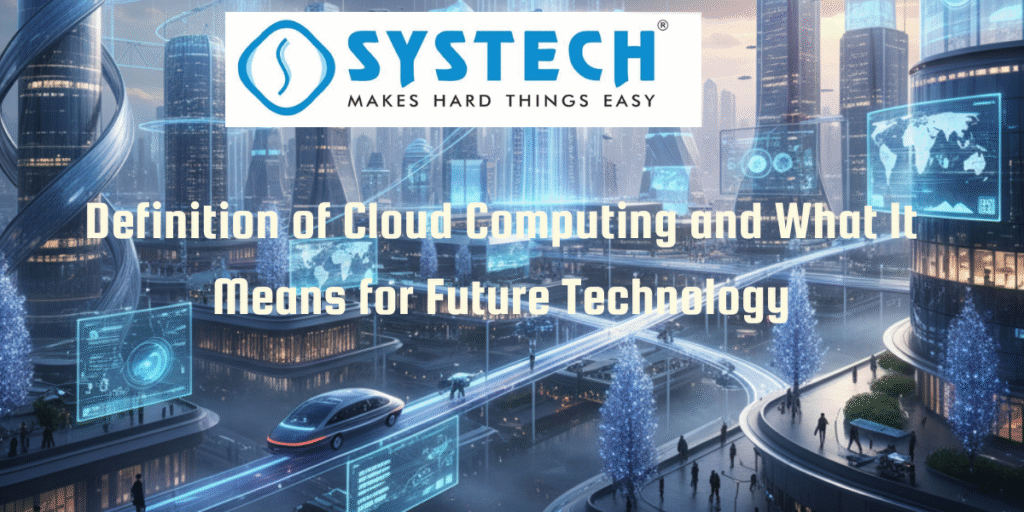Table of Contents
Introduction:
The definition of cloud computing is a crucial concept shaping the digital landscape today. With the explosion of data and digital services, businesses and individuals constantly struggle with managing costly IT infrastructure and demands for flexibility. Understanding the definition of cloud computing helps address these pain points by providing scalable, on-demand computing resources over the internet. This technology is revolutionising how technology services are delivered and utilised. This blog explores the definition of cloud computing and what it means for future technology.
What You’ll Learn
- A clear definition of cloud computing
- How cloud computing works in everyday scenarios
- Advantages of cloud computing for enterprises and users
- Importance of cloud computing in future technological advancements
- Real-world examples demonstrating cloud computing benefits
- An overview of Systech Group’s cloud computing training programs
What is Cloud Computing? A Clear Definition
Cloud computing is the delivery of computing services—including servers, storage, databases, networking, software, analytics, and more—over the internet, known as “the cloud.” Users access these resources on-demand without owning physical hardware. The National Institute of Standards and Technology (NIST) defines cloud computing as a model enabling ubiquitous, convenient, on-demand network access to configurable computing resources that can be rapidly provisioned and released.
Start Cloud Learning Today!
How Cloud Computing Works
To understand how cloud computing works, picture accessing software or storing files online rather than on your computer’s hard drive. Here’s a typical process:
- A user sends a request to access a cloud service, such as data storage or running an application.
- The request reaches a cloud provider’s remote data centre via the internet.
- The provider dynamically allocates needed virtual resources like servers and storage.
- The user’s tasks are processed on these virtual resources.
- The results or stored data are delivered back to the user over the internet.
Key technologies enabling cloud computing include virtualisation (creating virtual versions of physical resources), resource pooling (shared resources among users), and elasticity (scaling resources based on demand).
Advantages of Cloud Computing
Cloud computing offers many advantages that make it compelling for businesses and individual users:
- Cost Efficiency: Pay only for the resources you use, eliminating large upfront capital investments in hardware.
- Flexibility and Accessibility: Access your applications and data anytime, anywhere, using any internet-connected device.
- Scalability: Scale resources rapidly in response to changing business demands without delays.
- Reliability: Cloud providers offer backup, disaster recovery, and fault tolerance to ensure high availability.
- Faster Innovation: Quickly deploy new applications and technologies with reduced time-to-market.
Step Into the Future of Technology !
What Does the Definition of Cloud Computing Mean for Future Technology
The concept and adoption of cloud computing are transforming future technology in several crucial ways:
- Powering Emerging Technologies: Artificial Intelligence (AI), Internet of Things (IoT), and quantum computing depend on cloud infrastructure for processing vast amounts of data and providing scalable computing power.
- Democratising IT Access: Startups and small enterprises gain access to enterprise-grade infrastructure at affordable costs.
- Enabling Digital Transformation: Cloud computing accelerates business agility and innovation, empowering personalised customer experiences and seamless workflows.
- Promoting Sustainability: Cloud data centres increasingly emphasise energy efficiency and reducing carbon emissions, helping build greener technology ecosystems.
It’s not just about choosing the cheapest option—consider what comes with the package. A slightly higher fee may give access to comprehensive labs, expert instructors, and placement support.
Real-World Examples of Cloud Computing
- Google Drive and Dropbox enable users to store and access files in the cloud from anywhere.
- Netflix leverages the cloud to stream videos globally with minimal buffering.
- Amazon Web Services (AWS) supports businesses with scalable compute power, enabling rapid growth in e-commerce, fintech, and healthtech.
- Microsoft Azure and Google Cloud Platform provide tools for AI, machine learning, and big data analytics powered by cloud infrastructure.
Industry-Leading Provider for Cloud Skill Development
Systech Group is a premier technology training provider specialising in networking and cloud computing education. Their cloud computing courses cover foundational concepts like what cloud computing is, how cloud computing works, and advantages of cloud computing. With expert instructors and hands-on projects, Systech Group equips learners with practical skills to excel in today’s IT industry. Whether you’re starting your cloud journey or aiming to deepen your expertise, Systech Group offers the resources and certification to advance your career
Gain In-Demand Cloud Expertise
Conclusion:
The definition of cloud computing is pivotal for understanding today’s digital technology and future innovations. How cloud computing works and its advantages empower businesses and individuals through cost efficiency, scalability, and flexibility. Cloud computing is not just a technology—it’s the backbone of emerging tech trends like AI and IoT. Learning about cloud computing and acquiring practical skills is essential for anyone interested in networking and IT. Systech Group provides comprehensive training to help learners stay ahead in this exciting field. Embrace the power of cloud computing and transform your technology journey today.
FAQs:
What is cloud computing?
Cloud computing is the on-demand delivery of IT resources and services over the internet, allowing users to access servers, storage, databases, and applications without owning physical hardware.
How does cloud computing work?
Cloud computing works by allocating virtualised computing resources from remote data centres, which users access through the internet on a pay-per-use basis.
What are the advantages of cloud computing?
Advantages include scalability, cost reductions, flexibility in access, improved reliability, and faster deployment of technology solutions.
What is the difference between cloud computing and traditional IT?
Traditional IT involves managing physical servers, while cloud computing rents virtual resources dynamically from providers, reducing maintenance and capital costs.
How will cloud computing impact future technology?
Cloud computing supports emerging fields like artificial intelligence, the internet of things, and quantum computing, driving innovation and digital transformation.

